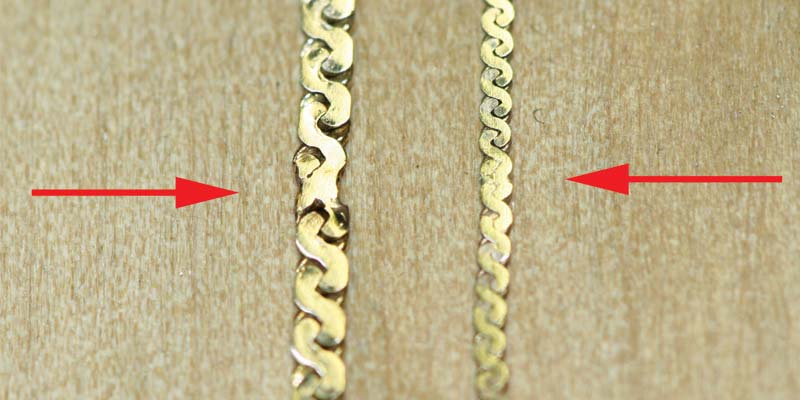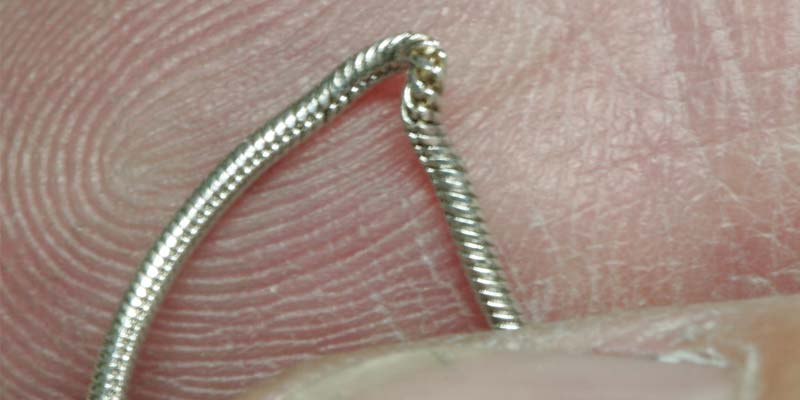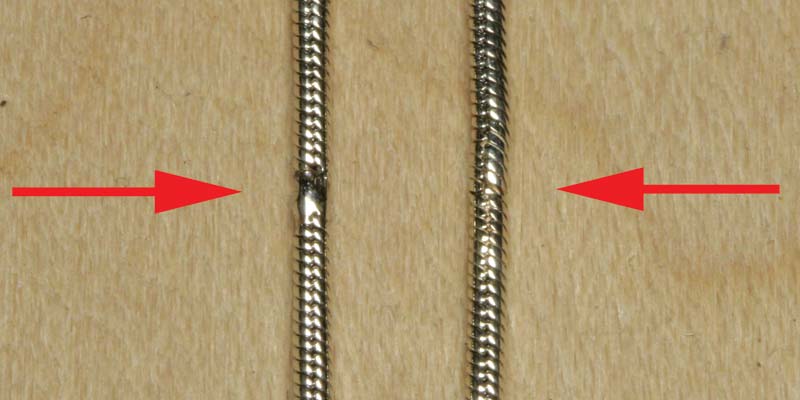Repairing woven chains
Depending on the type, woven chains can be very difficult to repair. Take, for example, hollow-link rope chains. These are typically stamped out of metal less than 0.10-mm thick. They are so thin, they have to be manufactured in temperature-controlled kilns. A torch will almost instantly melt one, while the links are sure to explode when a laser is applied. These chains are nearly impossible to repair unless you simply flood them with solder to build up mass. To me, it seems unfair for bench jewellers to be held responsible to do high-quality repairs on hollow chains.
Consider the kinked 1.2-mm diameter white gold snake chain in the top photo. The kinking occurred due to a rather heavy pendant being hung from it. The individual links in this chain are made of woven wires approximately 0.1-mm thick. To repair this chain, I used the same techniques for both torch and laser described in the section on repairing flat-link chains.
When I tried laser welding this chain, the wires exploded. Additionally, fusing the ends into a solid mass proved more difficult than the previous flat-link chain. I eventually used a white gold filler rod and overbuilt the ends of the chain before I could laser weld them together. The finished result came out bulky, requiring sanding and polishing. To torch-solder this same chain, I once again used peripheral heating.
As you can see in the bottom photo, the difference between the laser-welded chain on the left and the torch-soldered chain on the right is quite dramatic. Here, the repair is nearly invisible. With only a small stiff area, the result is one with which a client would be happy.
For slightly heavier link chains and adding clasps, lasers are the preferred repair method, while torch solders are more appropriate when working on chains made of thinner metals. The perfect solution is for jewellers to be proficient at using both pieces of equipment and to keep in mind which tool will achieve the desired result.
I’ve now concluded a year’s worth of ‘back to the basics’ articles. Through these columns, it has been my goal to illustrate how to properly complete the most common repair jobs using the right tools and techniques. I know through my own experience that when bench jewellers deliver outstanding quality to their customers, their reputation and success grow. Thank you to everyone for your feedback and questions.
Starting with the February issue, I will present a new series of articles that combine the skills and techniques shown during this past year in the creation of six custom-made pieces. These columns will illustrate and discuss more complex bench techniques ranging from advanced stone-setting to hand-engraving and fabrication. I hope you’ll join me as I go over the top on custom work.
 Tom Weishaar is a certified master bench jeweller (CMBJ) and has presented seminars on jewellery repair topics for Jewelers of America (JA). He can be contacted via e-mail at tweishaar@cox.net.
Tom Weishaar is a certified master bench jeweller (CMBJ) and has presented seminars on jewellery repair topics for Jewelers of America (JA). He can be contacted via e-mail at tweishaar@cox.net.











